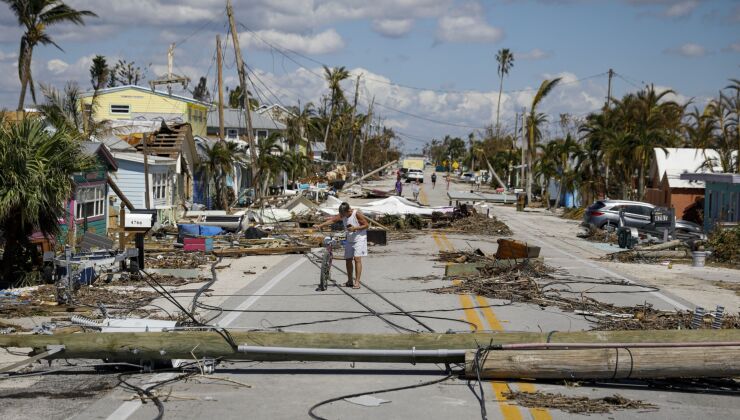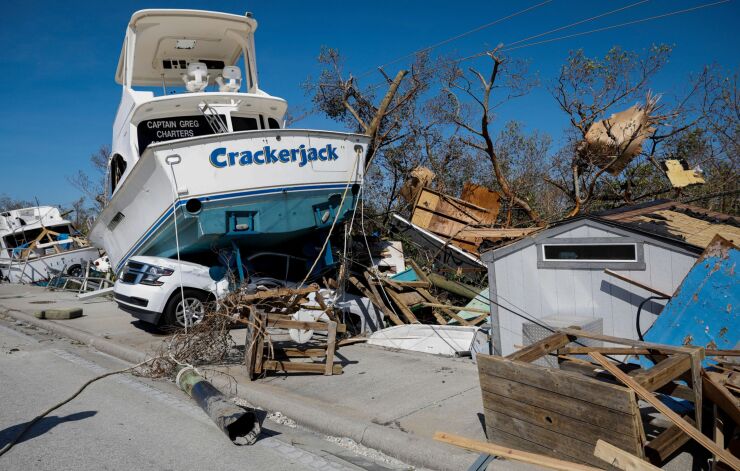Florida is facing a massive cleanup effort that won't be finished overnight, but the road to full recovery may be eased by the fact that the state was well-positioned financially before Hurricane Ian first touched land.
On Wednesday, Gov. Ron DeSantis met with President Joe Biden,who visited Ft. Myers, one of the areas hardest hit by the storm that Biden's called "among the worst in the nation's history."

While the Democratic president and Republican governor have feuded over politics, they have coordinated on federal aid for the state.
Biden has issued a disaster declaration which will facilitate Federal Emergency Management Agency reimbursements of substantial portions of storm recovery costs.
"We're really still in search and rescue mode right now," Ben Watkins, director of Florida's Bond Division, told The Bond Buyer Tuesday. "In the immediate aftermath of a catastrophic event like this, all the focus is on search and rescue and delivering food, water and ice and getting people a place to live, get them fed and get them out of harm's way — and they're still in that mode."
Watkins noted that the state was in very good financial shape going into the storm.
"We are extraordinarily well positioned to deal with this storm from a financial standpoint. Our reserves are at record levels with general fund reserves of about $19.3 billion and adding trust fund balances we are at $21.3 billion, nearly 51% of general revenues," he said.
"So we are very well positioned at the state level as well as the special purpose insurance entities that have been created in the state to deal with various attributes of the insurance industry such as residential property and casualty," Watkins said.
He said the entities included the
Watkins revealed the preliminary computer modeling estimates for losses for the state funds.
"On Cat Fund, the initial model loss estimates range from $6 billion to $13.6 billion. And we have resources on hand and available of $16.2 billion," he said. "On Citizens it's a similar story — their modeled losses range from $1.4 billion to $3.7 billion. They have total claims paying capacity of $13.6 billion — and of that $13.6 billion in capacity, they have $9.8 billion in cash and investments as of June."
Watkins said Florida's government also has plenty of liquidity.

"The state Treasury at the end of August had $52.9 billion — we've got a lot of money in the bank," he said. "These initial models can show people a sense of order of magnitude — but the loss development occurs over weeks, months and years as to what actually happens relative to what the models say at the outset in a not terribly accurate way."
Florida is rated triple-A by Moody's Investors Service, S&P Global Ratings and Fitch Ratings.
S&P said in a Monday report that while it's too soon to determine how the storm will affect the
Still, the hardest-hit localities must still come to grips with near-term issues such as rising inflation, which will raise recovery and building costs, along with long range concerns such as climate change,
Florida's long coastline makes it susceptible to
"The state's very strong financial management and revenue performance, particularity over the past three years, provides stability to the rating, in our view," S&P said.
S&P rates about 70 utility credits in Florida, 31 of which have been affected by the storm with main breaks, power outages, and system reliability issues including lack of water and boil notices.
Based on current information, S&P said it doesn't expect material impacts to these utility issuers' credit quality.
Jenny Poree, S&P sector lead for the water and sewer utilities group, told The Bond Buyer the rating agency is seeing some pretty significant infrastructure deficiencies on the water and power side, but that the recovery and emergency response was now well underway.
She said the rating agency was looking at the financials and running stress analysis on the credits.
"What's been fortuitous, at least from a financial and credit standpoint, for the Florida portfolio is that we take a very acute look at emergency response and asset management and most of these credits, although there's going to be significant rebuild, had very strong financial underpinnings going into the storm and the liquidity will help them recover, even if this recovery is going to be significantly longer than the historic norm for hurricane recovery," she said.
Watkins noted that at least for the first 30 days of the disaster, everything would be reimbursed by FEMA at 100% for debris removal and emergency protective measures in response to the hurricane.
On Wednesday, Biden
"FEMA reimbursements tend to lag considerably behind a storm event. Therefore, we are assessing issuers' ability to secure bridge loans to fund system repairs without depleting their liquidity cushions, pending receipt of FEMA money and any state assistance," S&P said.
"Historically, we have observed that prospects for FEMA and state relief have contributed to lenders' willingness to provide bridge loans for some issuers," S&P said. "However, even with auspicious prospects for receiving FEMA relief, some issuers might lack access to bridge financing which could erode liquidity and place negative pressure on ratings."
Poree said the federal and state aid will be supportive, but because it is not immediate having sufficient liquidity to cushion that reimbursement process is important in allowing rebuilding to take place at a much faster pace.
"The biggest risk to utilities is ratepayer and population dislocation," she said. "What we've seen from case studies and what we're expecting here and especially in Ft. Myers is that significant portions of the population will be displaced and during that period the water and power systems are not fully utilized and so there's a significant revenue collection dip where there's also increased expenditures — that's where the stress really occurs."
Moody's said in a Tuesday report that Ian's damaging winds, storm surge and heavy rainfall are an overall credit negative for Florida's local governments and public transportation and infrastructure issuers because they face substantial cleanup and rebuilding costs.
"The longer-term credit implications are likely to be limited for most Ian-affected public finance issuers in the state, thanks to the availability of federal disaster aid, insurance proceeds and, for most issuers, ample liquidity," said Moody's assistant vice president Lauren Von Bargen. "In addition, Florida's strong demographic and economic fundamentals are likely to support vigorous post-storm rebuilding, as in prior hurricane events in the state."
In the short term, the state is in good financial shape, Denise Rappmund, Moody's vice president and senior analyst, told The Bond Buyer on Monday.
"The state has historically high reserves right now and so that a big factor of our view of the state over the short term," she said. "They just have abundant financial resources ... it's in a strong position to cover whatever they need."
Rappmund noted that the Cat Fund had significant reserves on hand.
"They also have some pre-event bonds that are still outstanding," she said. "So with their resources on hand they can pretty much cover their full $17 billion liability cap."
She said Citizens gets some of its reinsurance coverage from the Cat Fund and between their reserves, coverage from the Cat Fund and other private reinsurance they purchased it has plenty to cover its liabilities.
"And if for some reason they aren't able to — and we are still waiting for really good estimates on the full extent of the damage — they have the option to issue bonds that would be secured by assessments that would be leverages off a huge assessment base," she said. "So they're pretty well positioned as well."

Hurricane Ian is shaping up to be one of the costliest storms to hit the United States, AccuWeather founder and CEO Joel Myers told The Bond Buyer on Tuesday.
AccuWeather originally forecast total damage estimates from Ian to be between $100 billion and $120 billion and has since updated its loss estimates to between $180 billion and $210 billion.
Hurricane Katrina in 2005 caused $320 billion in total damage and economic loss, adjusted for inflation, according to AccuWeather. Hurricane Harvey in 2017 caused $230 billion in damage while Hurricane Sandy in 2012 caused $210 billion.
"The insured estimates have ranged anywhere from $40 billion to over $60 billion and when you include federal flood insurance it's probably over $60 billion," Myers said. "But in our experience it's been that the total loss and economic damage from a storm is three to seven times the insured losses."
AccuWeather estimates are usually much higher than other estimates because other sources usually only factor in the insured losses while the AccuWeather estimates include total damage and its economic impact.
"Historically, many communities hit by storms see a temporary bump in sales taxes during rebuilding," S&P said. "While this provides revenue enhancement during a challenging time, rebuilding generally replaces what was lost rather than creating net growth in the economy."
Higher rated credits in Florida may fare better in the storm's aftermath, according to a Friday report from Bank of America Merrill Lynch Global Research.
"As always, credit matters. Higher-rated credits, including the state of Florida and these metros, are better positioned to recover from the economic disruption of these storms. This is evident by the strong recovery seen in the New York area following Hurricane Sandy compared to the weaker recovery in New Orleans. Additionally, Florida benefits from the National Flood Insurance Plan, as well as its own state-sponsored insurance programs," the report said.





